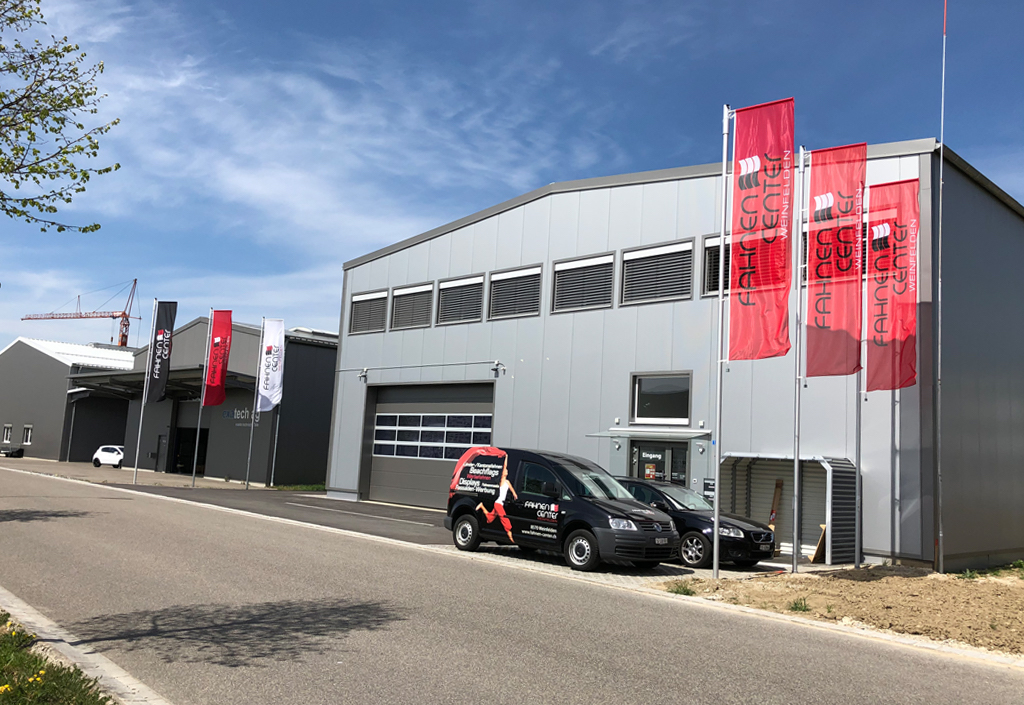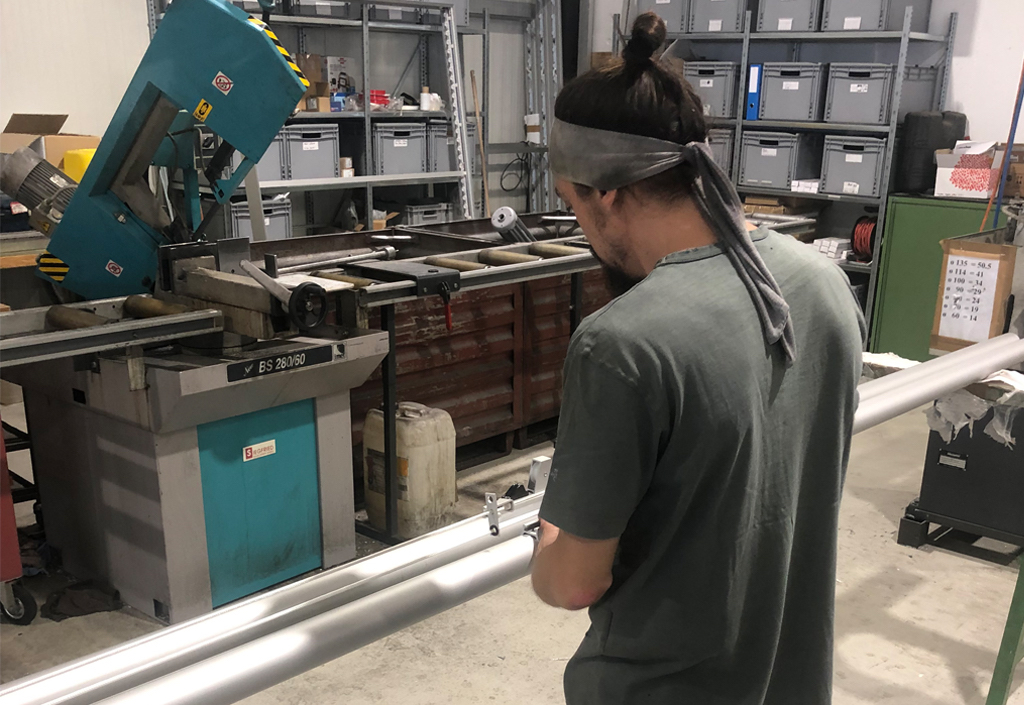How small Swiss firms keep innovating
Switzerland’s edge in innovation largely stems from vocational training and employee workplace activities, not academia or R&D departments.

In a nutshell
- An above-average number of Swiss small firms are above-average innovators
- Their in-house innovation is mostly evolutionary, not revolutionary
- The vocational training system is one of Switzerland’s greatest strengths
With its nine employees, Fahnen-Center Weinfelden GmbH (The Flag Center in Weinfelder) is a microenterprise. The boss-owner works shoulder to shoulder with programmers, fitters and apprentices. What lies behind the name is a cutting-edge advertising company. It sells mainly LED (digital display) advertising: hardware, programming and campaign implementation.
In many respects, Fahnen-Center is a typical small Swiss company. Initially, it produced flags and ventured into the sale of advertising materials. Today, the enterprise makes over CHF 6 million (5.94 million euros) in LED advertising sales. The interesting thing is that about half of the value of its purchases and more than a third of its sales are made abroad.
SMEs dominate Switzerland
The Swiss Federal Statistical Office figures show that the Flag Center is not alone. Over 99 percent of all companies in Switzerland have fewer than 250 employees. That makes them small- and medium-sized enterprises (SMEs). Such companies account for about 67 percent of all jobs and over 70 percent of apprenticeships. So far, so good; other economies report similar figures.
The surprising fact is that Swiss SMEs account for about 60 percent of the country’s added value, which is comparatively high. And they handle half of the country’s foreign trade, about 60 percent of imports and 45 percent of exports. No other country has such a high level of foreign trade participation by SMEs.
For the most part, innovation is evolutionary, not revolutionary.
Statistically, there is a category of “high-growth” companies, defined as market-economy enterprises with at least 10 employees at the beginning of the observation period and whose average annual employment growth over three years is over 10 percent. Again, SMEs are at the top of the list. About 11 percent of small companies have high growth; the figure is only 5 percent for large companies.
SMEs carry innovation
What accounts for this unusual dynamism of Swiss SMEs? In terms of regulatory policy, various elements point to an explanation: low taxes, efficient administrative framework, comparatively low regulation, politics as a secondary office, and many more. But another factor is much more compelling: an above-average number of Swiss SMEs happen to be above-average innovators.
Often, the perception of innovation is reduced to such matters as technology, research and development (R&D) and patents. Conversely, some may assume that SMEs that do not use high technology, do not register patents and do not have R&D expenditures cannot be innovative. The assumption is wrong.
It is equally wrong to claim that innovations must be disruptive. Disruption means breaking the existing business model or market. Most innovators only adjust their own business model – and thus only a part of the market processes. For the most part, innovation is evolutionary, not revolutionary.

Innovation is open in terms of content and results, and can affect the most diverse aspects of entrepreneurial activity. Also, it has no predetermined source. Studies suggest that about one-third of innovation in Swiss SMEs comes directly from employees. This innovation occurs during the execution of everyday tasks, not from laboratories and R&D departments. In SMEs, innovations are made on the job and in the market. Incidentally, they are rarely registered or patented because the relevant procedures are bureaucratic and complicated. But the fact that improvements are not formally recognized does not make them non-innovations. These innovations drive the growth of SMEs.
Vocational training and innovation
The same studies show that innovation in SMEs is related in several ways to vocational training. According to the State Secretariat for Education, Research and Innovation, some two-thirds of all young people in Switzerland complete an apprenticeship. They have a choice of about 230 occupations. They learn simultaneously in a company and vocational school for two to four years, thus receiving a solid foundation in their trade. After the apprenticeship, many go on to higher vocational education. They acquire specific qualifications and prepare themselves for management and specialist functions. There are around 410 vocational and higher professional examinations to certify the skills acquired and 52 courses at higher technical colleges.
The companies that initially recorded a net loss in the training process, later recouped the cost of the investment.
From 2000 to 2009, education economists Mirjam Strupler and Stefan Wolter conducted cost-benefit surveys for vocational education in Switzerland. Their conclusion: It is worthwhile to train apprentices. They compared 2,500 companies that trained apprentices with around 10,000 companies that did not, to find out that two-thirds of the firms achieved a direct net benefit from training apprentices.
And even in the final third, the companies that initially recorded a net loss in the training process, later recouped the cost of the investment. They benefited from employing the apprentice, thus avoiding expensive recruitment on the labor market, and generated specific know-how in promoting young talent for their own company.
According to studies by the economist Rico Baldegger, about one-third of company innovations comes from employees in the course of their work. That is, explicitly, not from R&D departments but from individuals directly involved in manufacturing products or providing services.
The reason for this, according to the study, is the high level of competence of employees who have completed vocational training. They are used to tackling challenges flexibly, integrating new information into the work process and thinking independently. This pragmatism gives them the necessary tools to implement new things on the job and in the market.
Vocational training ensures entrepreneurship
About a third of individuals who completed vocational training follow through to acquire further formal education. Continuing vocational education and training offers a wide range of options – seeking master craftsman’s diplomas or entering higher technical colleges and universities’ applied science departments. Incidentally, primary and continuing vocational training is one of the strongest forms of business cooperation. It is the companies that determine in their associations what should be taught. Depending on the sector, the state has no or only a subsidiary role. In Switzerland, the rule is that school follows the profession.
But vocational training also ensures competition by enabling young people to maintain professional standards, hold their own in the labor market and further develop their products and services and their own competencies. Vocational education and training (VET) thus drive diversity and lead to differentiation, innovation and competition. In Switzerland, it means lifelong learning. It is also de facto training in entrepreneurship.
Vocational training not only supplies the next generation of professionals and ensures employability but also leads to the permeability of dependent and self-employed activities. After years of employment, many professionals decide to become entrepreneurs themselves. This can happen by founding their companies or taking over the companies that offered them the initial training. The economist Silvio Borner estimated that about 15 percent of all professionals become independent entrepreneurs in their respective careers.
Scenarios
The Swiss system works well – even very well by international standards. But there are possible challenges. These can be laid out in three scenarios.
Societal attitude change
There could be a turn toward academic-oriented studies among the young generation. Because such education tends to be much less entrepreneurial and does not generate labor market skills, the trend would increase the ranks of the employees and the unemployed. Making things even worse, academic careers focusing on institutions and employment security set negative incentives for entrepreneurial thinking and thereby reduce the diversity of innovation. This would undermine the entire Swiss system. The risk that this scenario takes place can be estimated at 33 percent.
State takeover
Less consequential but still problematic would be an increase in state paternalism leading to stilting the contents of vocational education and training. The system is jeopardized if certain economic developments are not taken up, such as process management, digitization, new work and manufacturing technologies or productivity management. This can quickly happen when the state begins to interfere in the system. After all, state bureaucracy is not only distant from the market but also a believer in general schooling. Still worse, the state could turn vocational education into folklore – a disastrous consequence for Switzerland as a business location. Again, the estimated probability of such a scenario is 33 percent.
Diluted focus
Under a better but far from ideal scenario, professional training still trumps purely academic schooling. Professionals remain empowered to act independently and be entrepreneurial. However, the trend toward increased interference by the state and general education preference will continue. In some cases, professional associations, lured by subsidies and favorable regulations, may be tempted to enter into increased cooperative ventures with the state. The price of such a seemingly marginal change could prove high. Switzerland would gradually lose its economic flexibility and innovation potential, becoming a follower instead of a trendsetter. Here, too, the probability is 33 percent.
Optimism despite it all
The Flag Center employees in Weinfelden note the trends, but they stick to their ways. Aside from the two apprentices, no one in the company comes from the industry. Neither the owner nor the employees in assembly and programming studied coding or setting up the LED hardware. They have learned these skills on the job and in the market. For them, this process was an innovation. The change in business strategy from fabric flags to information technology was an innovation for the company itself.
They all managed to do that because they have been flexible. The vocational training and further education conditioned team members into seeing changes in work, and the company’s strategy, as entrepreneurial actions. These succeed if one dares to do something new - break up institutions disregarding security. If people do not lull themselves into a false security, everything will work, says the owner.








